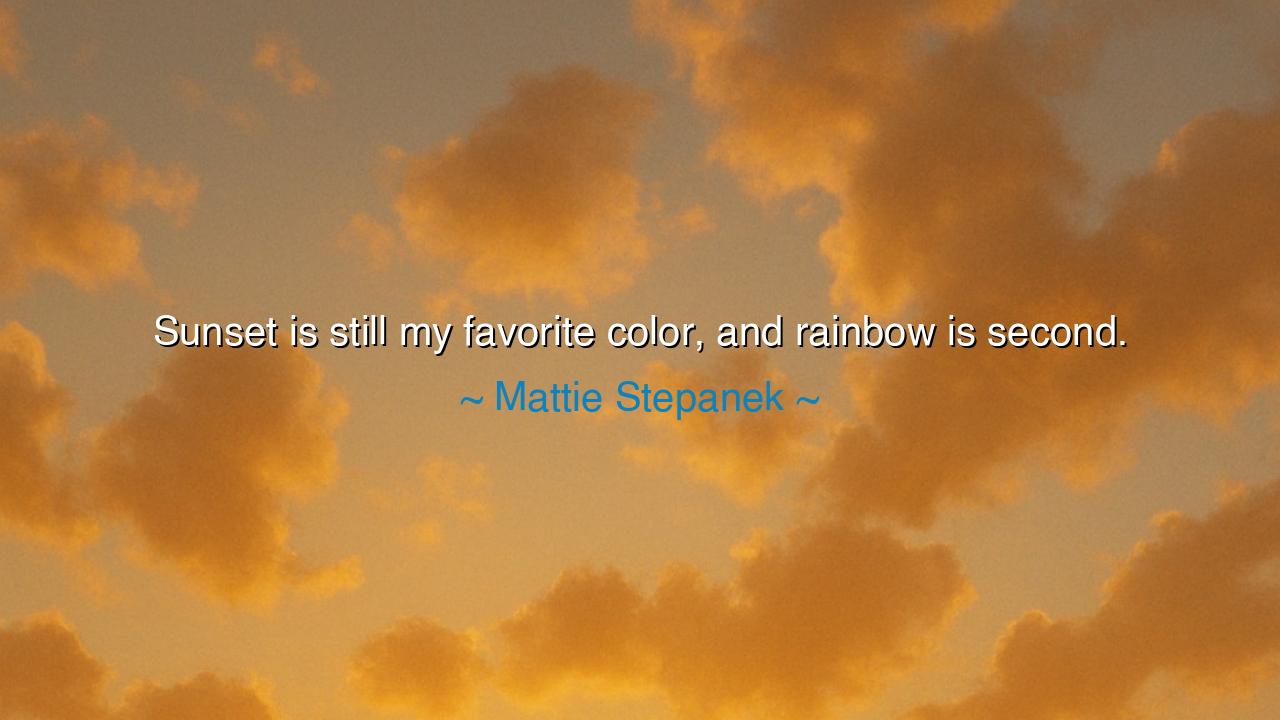
Sunset is still my favorite color, and rainbow is second.






Hearken, children of reflection, to the words of Mattie Stepanek, who beheld the world with the wisdom of ages: "Sunset is still my favorite color, and rainbow is second." In these words lies a meditation on beauty, wonder, and perspective, on the ability to find joy and meaning in fleeting moments of brilliance. Stepanek teaches that life’s grandeur is often found in the simple, ephemeral gifts of nature, and that the soul, attentive and open, can discover delight even amid sorrow and impermanence.
The first revelation is the transcendent power of observation. A sunset, in its slow descent, transforms the sky into a tapestry of fire and gold, reminding the watcher of the passage of time, the cycle of day and night, and the impermanence of all things. By declaring it his favorite color, Stepanek honors not only the visual beauty, but the symbolism of endings, reflection, and quiet wonder. In these fleeting moments, the heart is awakened to gratitude and reverence.
The rainbow, second in his affection, evokes the mystery of light, water, and promise. It is a bridge between rain and sun, sorrow and hope, a fleeting arc that appears after the storm. To choose rainbow as a favorite is to celebrate resilience, connection, and the multicolored richness of life. Stepanek teaches that beauty often follows struggle, and that wonder can be found in the interplay of light and shadow, loss and renewal.
History offers mirrors of this insight. Consider Claude Monet, who painted the same haystacks and water lilies at different hours of day and light, seeking to capture the ephemeral dance of color and atmosphere. Monet understood that beauty is temporal and context-dependent, and yet it conveys eternal truths about perception, patience, and the soul’s capacity for awe. Like Stepanek, he treasured the fleeting gifts of the world, allowing them to shape his spirit and vision.
Stepanek’s words also speak to the cultivation of delight amidst limitation. He lived with a life-shortening illness, yet found wonder and joy in the ordinary and extraordinary alike. His attention to sunset and rainbow demonstrates that even when circumstances constrain, the soul can perceive and celebrate beauty. To do so is an act of courage, mindfulness, and spiritual resilience, a choice to embrace life’s gifts fully.
The lesson extends beyond aesthetics to the rhythms of daily existence. By attuning oneself to the colors, sounds, and patterns of the natural world, one cultivates presence, gratitude, and reflection. Life’s fleeting beauty, whether in a sunset, a rainbow, or a quiet moment of connection, teaches patience, humility, and wonder. Stepanek’s preference reminds us to seek and cherish the extraordinary within the ordinary.
Practically, the teaching invites one to pause, observe, and savor. Walk at dusk, behold the sky’s transformation, watch for the sudden arc of a rainbow after the rain. Let these experiences awaken joy, inspire reflection, and cultivate gratitude. In this way, the soul becomes attuned to life’s fleeting beauty, discovering richness and serenity even amid the trials and transience of existence.
Thus, let this teaching echo through generations: the world offers color, wonder, and delight to those who see with attention and reverence. The sunset, with its fiery brilliance, and the rainbow, with its multicolored promise, remind us to cherish the fleeting, celebrate the beautiful, and let every moment awaken the heart to the grandeur and mystery of life. In this simple devotion lies the art of living fully, joyfully, and with deep awareness.






AAdministratorAdministrator
Welcome, honored guests. Please leave a comment, we will respond soon